Food Review: YAMASAN SUSHI (Omicho Market, Kanazawa)
Address: Kanazawa-shi, Shimo-Omicho 68
Hours: Daily 08:00-20:00
Website/Map: From Official Site
Directions: From Kanazawa Station, you can walk for 20 minutes or take a tourist bus to get to the Omicho Market. Yamasan Sushi is near the Northwest exit of the market ... everyone knows this place.

I'm a seafood fanatic, and inside this photo shows some of the freshest seafood I've ever had -- certainly the freshest Buri (yellowtail) and Snow Crab. Overall quality was at least as good as the internationally famous and incredibly popular Sushi Dai at Tokyo's Tsukiji Market, but without the two-hour lineup. The price was very reasonable for this top quality, as this 18-topping Kaisen-don set me back only 2625 yen (CAD$26). If I had to pick one Kanazawa restaurant to recommend, this is it -- the 60-year-old institution of Yamasan Sushi.

Located just inside the Omicho Market's Northwest Exit, Yamasan was one of the only eateries open early in the morning (08:00), and thus our natural choice for a filling sushi breakfast. It's your prototypical, traditional style Sushiya with two Chefs running the show behind the counter, a couple of Zashiki rooms on the side, and the Chefs' wives doing the kitchen work and the serving. The menu prices ranged from 1365 yen (CAD$14) for a Nigiri set to 2940 yen (CAD$30) for a Tokujo (Deluxe) Nigiri. And if you want your sushi in Chirashi style, an Omakase-Don was priced at 1575 yen, my Kaisen-don at 2625, and the top-of-the-line shucked Snow Crab or "Uni + Ikura" on rice cost 3150 yen (CAD$32).

A closer look and you'll see an unmistakably Kanazawa touch in the presentation -- a sprinkling of gold leaf flakes on the centerpiece of the dish. The Amaebi was fresh as expected, but the Ikura, the Buri, the Chu-Toro, the Uni and the Kaibashira were just top notch. And last but not least, there's a whole, fresh Snow Crab pincher stuffed at the back of the bowl. To this day I still remember this as one of my three favorite crab dishes.
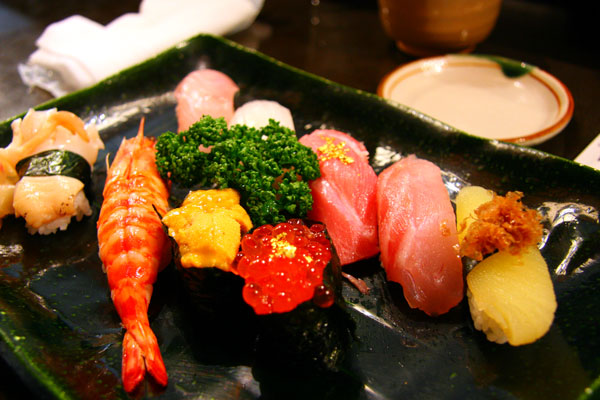
And my wife, being a light eater, ordered the 2940 yen (CAD$30) Tokujo Nigiri set. Again, note the light dusting of gold leaf flakes on the Ikura and the Otoro -- this seems to be the signature of Kanazawa restaurants wherever we go. I can't comment on the freshness, but according to my wife the Ikura and the Uni were the freshest she has ever had.
I must apologized that ... I forgot to photograph the MOST IMPORTANT PIECE of sushi in the Nigiri Set -- a whole half-shelled Snow Crab claw which my wife finished before I could grab the camera. But you get idea ... it was some of the freshest sushi money can buy, short of sitting aboard a fishing boat.
Bill for Two Persons
| Kaisen Don | 2625 yen |
| Deluxe Nigiri-zushi | 2940 yen |
| TOTAL | 5565 yen (CAD$56) |
Food Review: KAISENDON-YA (Omicho Market, Kanazawa)
Address: Kanazawa-shi, Jikken-machi 32
Hours: Daily 11:00-21:00; Closed Thursdays
Website/Map: From Yahoo Japan
Directions: From Kanazawa Station, you can walk for 20 minutes or take a tourist bus to get to the Omicho Market. Kaisendon-ya is located at the perimeter of the market's south end.
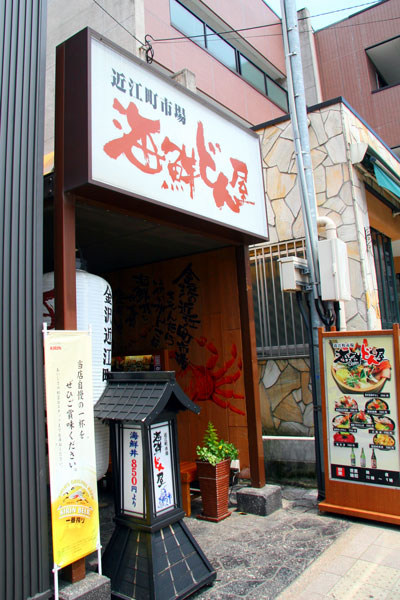
When a restaurant dares to name itself after a particular dish, typically I would expect something different about its interpretation of that dish, or perhaps simply superior in its ingredients or preparation method. In this case, the Kaisen-don is the cheap and common seafood ricebowl found at any fish market anywhere in Japan, so I had been anxious to come and evaluate the freshness of the Sushi Neta here after reading good reviews on TabeLog about this little joint just outside of the Omicho Market.
Even though there's no English menu outside, the colorful pictures and prices on the Japanese menu board is enough to tell you that this is a reasonably priced neighborhood place for seafood. And if you can read Japanese, you're probably already attracted by the sign that says "Kaisen-don from 850 yen" (CAD$8.5). Now that is an unbelievable price no matter where in Japan you are.
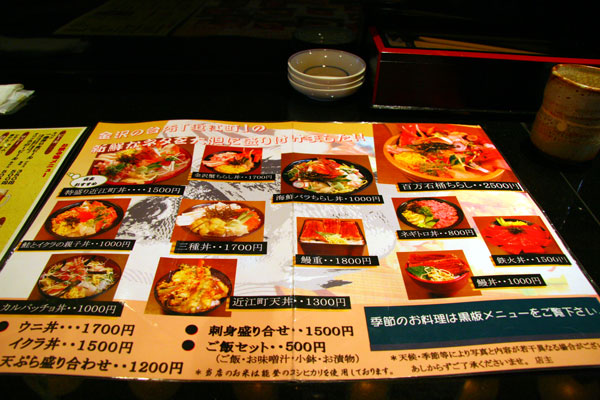
Here's the menu, no fancy Nigiri-zushi here, just seafood bowls of all types:
- Negitoro-don (chopped tuna and green onion) - 800 yen (CAD$8)
- Salmon and Ikura Oyako-don - 1000 yen (CAD$10)
- Carpaccio-don (thinly-sliced seafood) - 1000 yen
- Kaisen Bara Chirashi (mixed seafood) - 1000 yen
- Unagi-don - 1000 yen
- Omicho-Ten-don (Tempura) - 1300 yen (CAD$13)
- Tekka-don (Tuna) - 1500 yen (CAD$15)
- Large Omicho-don (variety of seafoods) - 1500 yen
- Sanshu-don (Uni, Ikura, Snow Crab) - 1700 yen (CAD$17)
- Kanazawa Crab Chirashi - 1700 yen
- And finally, the mother of all Kaisen-dons ... they've got a Kaisen-don in a bucket (called Hyakuman-goku Oke-chirashi) ... for 2500 yen (CAD$25)
Well, I figured we could afford to splurge at a cheap family-run place like this, and so we ordered two of the more expensive items.
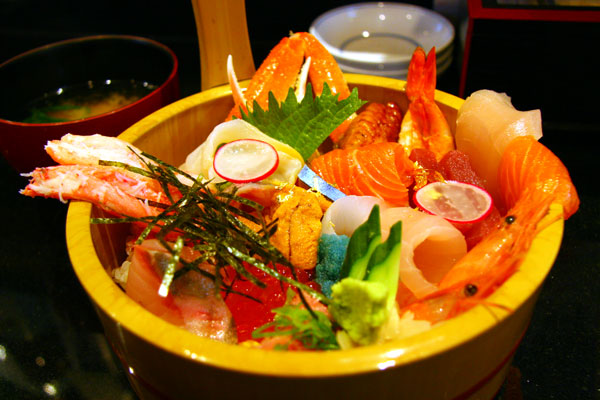
Here's the Oke-chirashi ... certainly the most impressive-looking ricebowl I've ever had ... though technically I'd have to call it a rice-bucket. It's not really as big as it sounds -- the container was similar to the type of hand-bucket you see at most Japanese public baths. The portions were somewhat larger compared to Yamasan Sushi, though the freshness was just a notch lower. It's still exceptionally fresh compared to most Kaisen-don places in other parts of Japan though, crowned by the excellent Uni and the local Snow Crab. And of course, it wouldn't be a Kanazawa style Kaisen-don without the dusting of gold leaf on the Uni.
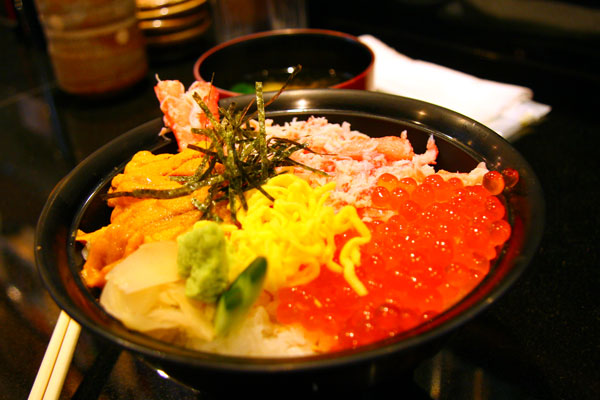
In retrospect I would have preferred my wife's Sanshu-don (3 types of seafood on rice), but I didn't expect the Uni and Snow Crab to be this good. The Ikura was also terrific, and this is according to my wife, who never orders Ikura outside of Japan.
So was it better than Yamasan Sushi? Not quite. But was it worth the money? Most definitely. Do I still recommend it? Yes, but only for the cheaper varieties of Kaisen-don. If you're planning to go for the bucket, I think Yamasan's Kaisen-don is a much better value at roughly the same price.
Bill for Two Persons
| Hyakuman-goku Oke-chirashi | 2500 yen |
| Sanshu-don | 1700 yen |
| TOTAL | 4200 yen (CAD$42) |
Food Review: OMICHO SHOKUDO (Omicho Market, Kanazawa)
Address: Kanazawa-shi, Aokusa-machi 1
Hours: Daily 10:30-15:00, 17:00-20:00
Website/Map: From Official Site
Directions: From Kanazawa Station, you can walk for 20 minutes or take a tourist bus to get to the Omicho Market. Omicho Shokudo is just inside the West Exit of the market.
The word Shokudo typically refers to a cafeteria or a canteen, and to market workers and lunch-seeking salarymen working in the neighborhood, this is THE place for fresh and inexpensive seafood. Whether you want your fish as sashimi, as shioyaki, simmered or baked, they've got it. In fact, in terms of quality vs price, this is probably one of the best places in Kanazawa.
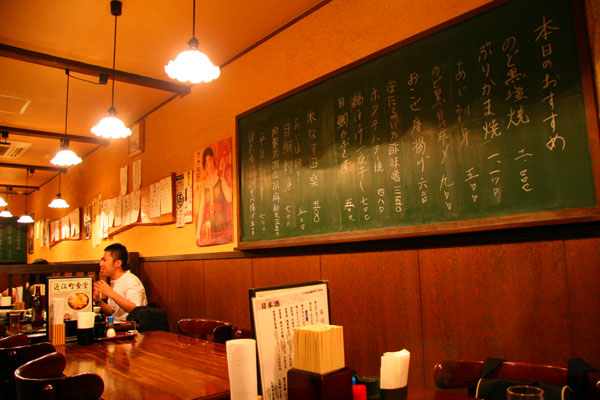
This is how it works ... you pick any entree -- starting from as little as 500 yen (CAD$5) -- and then add 400 yen for a dinner set with a Miso soup with clams, a Hiya-yakko tofu appetizer, two small vegetable dishes, and a bowl of rice. So we're talking a simple 6-course seafood dinner for 900 yen (CAD$9), quite a bargain no matter how you look at it.
As with most Shokudo type places, the daily menu is scribed on a chalk board -- in Japanese of course, but you could ask the waitress for a little translation. When we visited in May, the seasonal menu included:
- Scallops Butter-Yaki - 480 yen (CAD$5)
- Aji Sashimi - 500 yen
- Medai no Kabuto-ni (braised head of snapper) - 500 yen
- Okoze (stinger fish) Karaage - 600 yen
- Medai (snapper) Sashimi - 700 yen
- Hirame (sole) Sashimi - 700 yen
- Shiro-ebi (white shrimps) Sashimi - 900 yen
- Nodoguro Konbu-shime (blackthroat sea perch sashimi in seaweed) - 900 yen
- Buri Kamayaki (grilled yellowtail cheek) - 1100 yen
- Hotaru-Ika Su-miso (florescent squids in miso-vinaigrette) - 1250 yen
- Nodoguro Shioyaki (grilled blackthroat sea perch in sea salt) - 2000 yen (CAD$20)
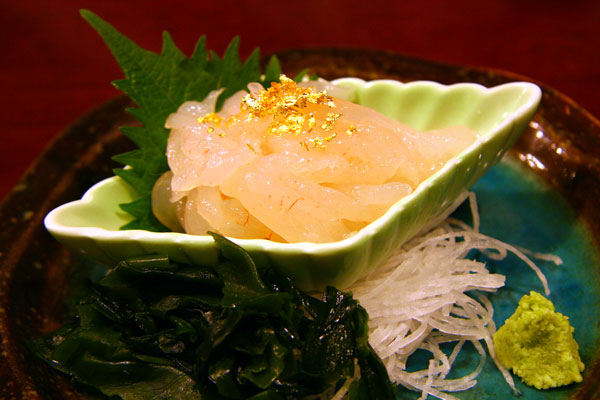
Well, you know where this is going -- we tend to splurge where we could afford to splurge -- and so the two of us ordered four entrees in total, including the 2000 yen Nodoguro fish I had heard so many good things about and just couldn't wait to try.
The shimmering Shiro-ebi Sashimi (900 yen) was the first to arrive. Although literally translated to simply "White Shrimp", the Shiro-ebi is a local specialty caught off the waters of Toyama Bay and seldom sold in restaurants outside of the Sea of Japan coast. We've had the fortune of sampling this incredibly sweet crustacean once in Tokyo, and on this trip to the producing-region it was one of the items we deliberately looked for.
Just look at that shine on the semi-transparent shrimp! If you ever end up on the Sea of Japan coast, do yourself a favor and ask for Shiro-ebi ... you'll thank me for it.
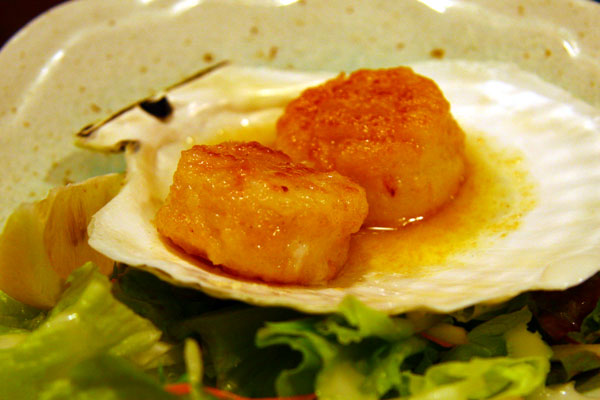
Next up was the Scallops Butter-Yaki (480 yen), lightly starched, baked in its own shell and served with a salad. The scallops were perfectly done, though the size was better suited as a appetizer than an entree.

Here comes the Nodoguro we've been waiting for -- a smaller fish than I anticipated for its price (2000 yen). The meat had a silken, oily texture ... the best comparison I can think of is the oiliness of Chilean sea bass with the softness of a flounder. Sorry if I'm a little vague, but I've never had any fish like it. With a delicate fish like this the sea salt and a quick squeeze of lemon made the perfect seasoning, and it was so well-grilled that I even finished the crispy fins and tails. Was it worth it? Definitely. Would I order it again next time? Tough question ... Kanazawa has so many other famous dishes awaiting the adventurous ...
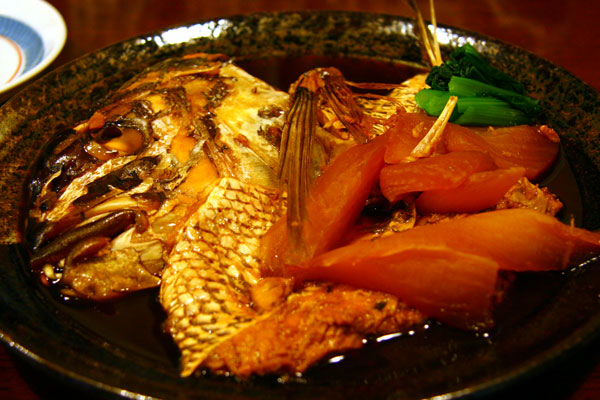
The final entree dish was the Madai no Kabuto-ni (600 yen), a whole snapper head simmered in a mirin and soy-based sauce, and served with your typical daikon radishes. The fish was fresh but overcooked, and the quality was just way below the other dishes.
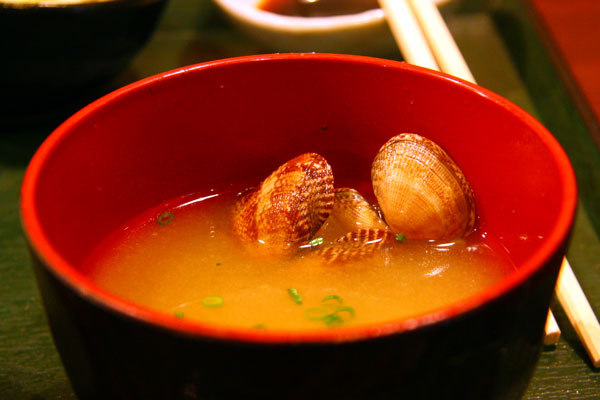
We couldn't resist also ordering the 400 yen dinner course -- how could we turn down five courses for 400 yen? Just this Asari-Miso soup is worth 400 yen at some higher end sushi places.
So which were the best dishes? The Shiro-ebi and Nodoguro were definitely the stars of the meal (and appropriately priced for their excellence too). The Asari-Miso soup was also very good. We wouldn't mind coming back for dinner, if we ever end up in Kanazawa again.
Bill for Two Persons
| Shiro-ebi Sashimi | 900 yen |
| Nodoguro Yaki | 2000 yen |
| Scallops Butter-Yaki | 480 yen |
| Madai no Kabuto-ni | 600 yen |
| Dinner Sets x 2 | 400 yen |
| TOTAL | 4780 yen (CAD$48) |
Hotel Review: CITY INN KOBAYASHI (Kanazawa)
Address: Kanazawa-shi Tamagawa-machi 11-1
Price: 6000 yen for a Japanese-style double room with private bathroom
Website/Map: http://www.yadotime.jp/shisetsu/28/index.php
How To Book: You get the 6000 yen price only if you book through JALAN.net, which is for Japanese-readers only. If you can't read Japanese, email them at cityinn@spacelan.ne.jp and expect to pay 7000 yen for a double room.
Directions: From the Kanazawa Station, it's easiest to: A) walk for 15 minutes, or B) take the FLAT BUS KONOHANA (costs only 100 yen) and get off at Musashi-ga-Tsuji.
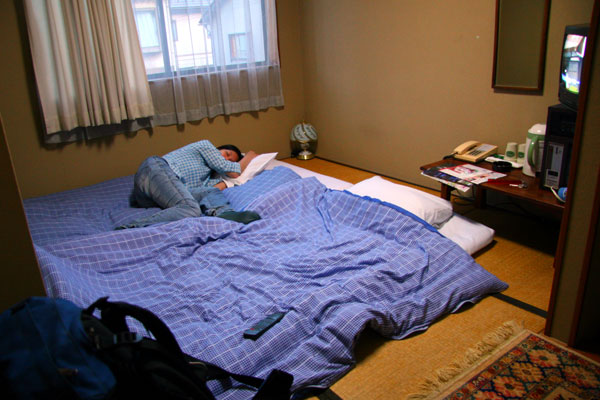
I think this is probably the first ever English review on this simple budget hotel, as I tried to search for English reviews myself prior to booking this place, but couldn't find any and ended up finding tons of reviews at Japanese sites.
You can see it all in this picture: a character-less but clean 6-Tatami Room sleeping two people, a little coin-op TV, air-con, cheap Futon mattresses and blankets, but at a rock bottom cheap price too -- a measly 6000 yen (CAD$60) for a double room with private bathroom at the heart of Kanazawa. Exactly what you'd expect from a no-nonsense business hotel anywhere in Japan.
City Inn Kobayashi is housed in its own three-storey building located near the Musashi-ga-Tsuji intersection at the centre of Kanazawa's urban core. A 10 minute's walk to the Northwest brings you to the JR train station; the shopping district of Korinbo is 15 minutes to the south; and most importantly for us, it's just 3 minutes walk away from the Omicho Market for the freshest seafood. Bus stops for both the LOOP BUS and the FLAT BUS are just a few minute's walk away, so it's also very convenient to reach all the main tourist attractions. And since central Kanazawa isn't really that big, a 20 minute walk would bring you to the front gate of Kanazawa's number one attraction -- the Kenroku-en.
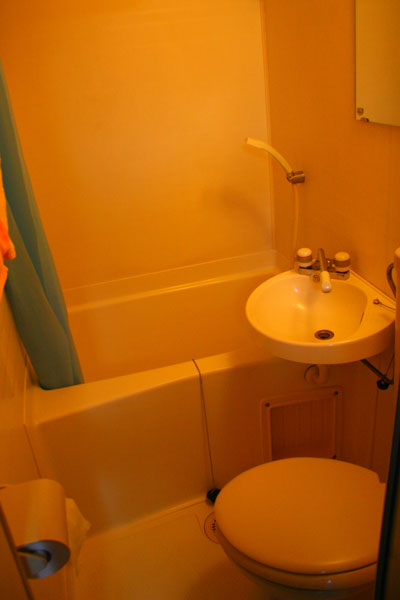
Like most family-run business hotels, its main clientelle are salaryman-workers and budget-conscious young Japanese travelers. The friendly, 50-ish-year-old owner didn't seem to speak any English, but knew exactly what we needed when he took in our backpacks when we arrived at 11:00, four hours before the check-in time. When we returned after a long day of sightseeing, our backpacks were waiting for us in our own room -- just what you'd expect from higher-priced hotels and Ryokans. Do note that they impose a curfew at midnight, so make sure not to get too drunk at the neighborhood Izakaya.
TRANSPORTATION
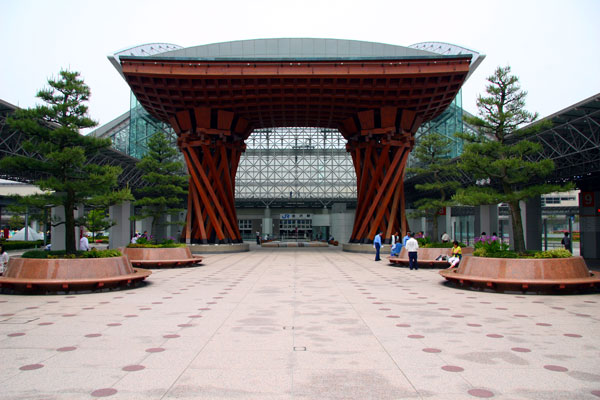
Kanazawa is a major train station on the western coast of Japan, just 2 hours away from Kyoto by Express train (nicknamed "Thunderbird"). If you come from Tokyo, the quickest way is to take the Shinkansen train to Echigo-Yuzawa, then transfer to an Express train to Kanazawa, taking a little over 4 hours in total. If you want to save on hotel costs, there's also an overnight bus leaving around 23:30 from Shinjuku Station and arriving at 08:00 at Kanazawa for only 4100 yen. Check out http://www.123bus.net/ if that's your preference.
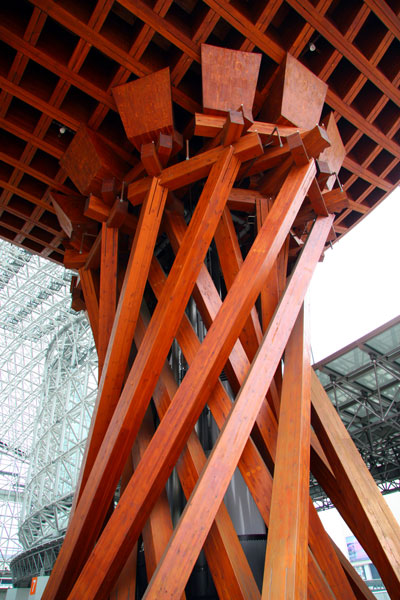
Once arriving at Kanazawa Station you'll see these huge wooden spindles outside the station. Besides being a symbol of the city's modernization, they also conveniently mark the location of the main bus station for self-serving tourists like us. With the areas of major tourist interest scattered on the outskirts of the old castle grounds, the several tourist-focused bus route are probably the best way to cover the sights in a time and stamina-efficient manner.
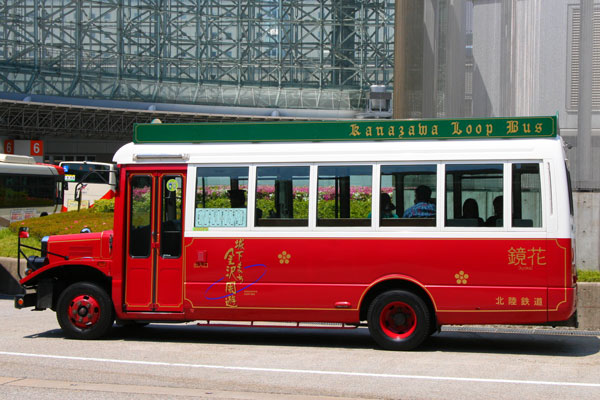
The easiest way is the LOOP BUS (also see official site in Japanese), which departs from the Kanazawa Station at 12 minute intervals from 08:36 to 18:00, snakes around most of the major sights and back to Kanazawa Station in 40 minutes. Major stops of interest include:
- Baba Jido Koen (1 minute walk to Hakuza)
- Hashiba-cho 4 (2 minute walk to Higashi Chayagai)
- Kenroku-en Shita (just outside Kenroku-en garden)
- Korinbo 7 (2 minute walk to Nagamachi Samurai District)
- Musashi-ga-Tsuji (1 minute walk to Omicho Market)
A single trip costs 200 yen (CAD$2), so the 500 yen (CAD$5) Day Pass probably makes more sense for most tourists.
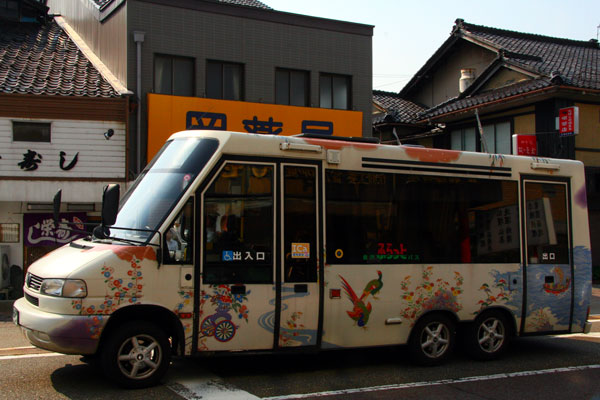
But we didn't take the Loop Bus -- there's another alternative called the FLAT BUS, which has three different routes going around different parts of the city for 100 yen (CAD$1) a trip. The Official Kanazawa Tourism Site has a fairly good explanation of these routes.
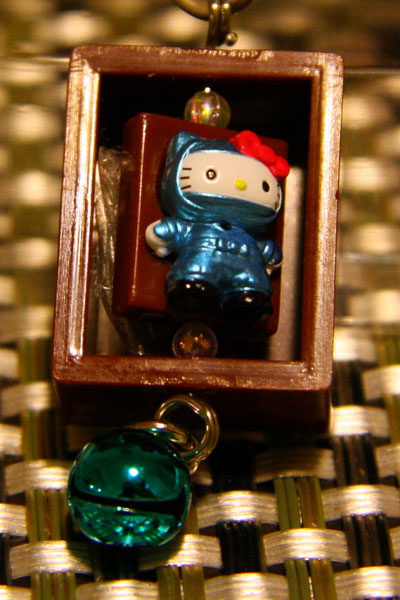
Không có nhận xét nào:
Đăng nhận xét